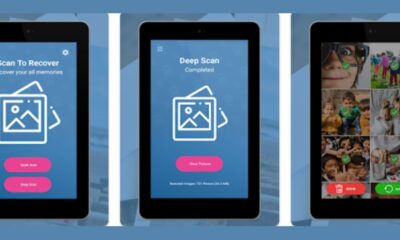Tech
AXDF44: A Complete Guide

In the ever-evolving world of technology, certain keywords, terms, and codes often appear with various implications in engineering, technology, and research. One of these terms, AXDF44, has garnered attention across several fields. This guide dives into everything there is to know about AXDF44, including its potential applications, functionality, and relevance in modern technological contexts.
What is AXDF44?
AXDF44 is a term that has been explored in various technological and scientific applications, often associated with engineering codes, components, and digital frameworks. Though not a universally recognized term, it signifies a specific technological identifier that can apply to fields ranging from robotics to computational research. AXDF44 functions as a placeholder name in several scenarios where components, algorithms, or unique identifiers are referenced, and it may serve as a designation for a prototype, concept, or experimental project within a technical framework.
The Origins and Naming of AXDF44
The origins of the term AXDF44 may trace back to standardized naming conventions in engineering and technical sciences. In engineering and computational fields, alphanumeric combinations like AXDF44 are often used to denote prototypes, codes, or specific classifications of components. AXDF44 could stand for an engineering project, component part, or a specific program or software tool under development, though its precise meaning often depends on the field and context of its use.
Applications of AXDF44 in Technology and Engineering
The potential applications of this identifier in technology and engineering are numerous. It might be found within electronics, serving as a reference to a circuit component or electronic design. In computational settings, this identifier can act within programming structures or coding systems that help map functions or algorithms. These applications highlight its potential in creating standardized processes, enhancing automation, or enabling machine learning algorithms.
In Computing and Software Development
In software development, AXDF44 can serve as a project code or identifier for specific software components or algorithms. Programmers often use unique codes like this to label software builds, versions, or unique functionalities within a development cycle. If tied to a certain module, this code can also represent an algorithm or specific function within a broader software environment, supporting processing tasks or data analysis. visit wepbound is the ultimate destination for comprehensive insights into tech, business, crypto, and fashion, offering diverse information all in one platform. It proves particularly useful in iterative software development processes, where modular identification streamlines testing and implementation.
In Robotics and Automation
Within robotics and automation, AXDF44 might designate a specific motor type, sensor, or robotic component used in assembly lines, manufacturing, or even autonomous vehicles. Robotic engineers utilize identifiers like this to organize and simplify the management of various parts, each with its unique function within a complex robotic system. Whether representing a sensor in a robotic arm or a specialized actuator, this code facilitates efficiency, reliability, and scalability in automated systems.
In Experimental and Research Settings
AXDF44 can also be associated with experimental projects or research where unique codes are essential for documentation and identification. In research labs, identifiers like this one classify experimental groups, technology trials, or prototypes under evaluation. This systematic approach ensures consistency and traceability, especially when extensive testing or comparisons across experimental runs are required. A structured code like this enhances clarity, especially in multidisciplinary collaborations.
Benefits of Using Identifiers
The use of identifiers like this one offers numerous benefits in technical fields. One major advantage is the reduction of ambiguity, providing clarity in complex processes or large-scale projects. With such identifiers, engineers and programmers can communicate effectively, reducing the likelihood of errors in identification across robotic assembly lines or data-intensive software programs. This naming convention also aids in documentation, creating efficient records for future reference.
Enhancing Efficiency in Complex Systems
Complex systems rely on numerous integrated components, each with distinct roles. A naming convention like this simplifies component differentiation, which is essential in large, automated systems. For instance, AXDF44 might label a part in high-volume manufacturing, where multiple components interact in real-time. This efficiency allows engineers to manage and troubleshoot systems without misidentifying parts, ultimately reducing downtime and increasing productivity.
AXDF44 Role in Quality Assurance
Quality assurance (QA) is another field where unique codes like this play a vital role. In product testing and verification stages, such identifiers help QA teams manage component validation, performance testing, and troubleshooting. Through structured naming conventions, QA personnel can track each part’s quality and performance individually. If this code is linked to a particular component or code sequence, it enables specific quality checks and metric analysis, helping manufacturers maintain high standards across their products.
Common Challenges and Misunderstandings
Despite its utility, the use of identifiers can lead to misunderstandings or confusion, especially among those unfamiliar with coding or engineering terminologies. Misinterpretations of codes like this may occur if proper documentation is lacking, leading to delays in troubleshooting or repairs. Ensuring that every team member understands its role in a project is critical to avoiding such issues. Clear training and accessible documentation help mitigate these challenges, enhancing overall project effectiveness.
AXDF44 Documenting in Project Files
Documentation is essential in any project involving unique codes. Effective documentation should include the code’s role, associated parts, specifications, and any changes made over time. By recording the purpose and parameters, technical teams establish a reference that streamlines collaboration and aids in future troubleshooting. This process is particularly useful when projects span multiple phases or involve numerous stakeholders who may not be familiar with every component.
Standardization in Engineering Protocols
In engineering, standardized codes are part of broader efforts to maintain uniformity across project elements. Standardization ensures that each part or module is consistently recognized across different systems, helping engineers save time when integrating or replacing parts. Such identifiers may form part of industry-wide standards or specific company protocols, emphasizing compatibility, efficiency, and ease of maintenance throughout a project’s lifecycle.
Future Implications in Technological Advancements
As technology continues to evolve, the role of codes like AXDF44 may expand. With the advent of more intricate automated systems, AI-driven components, and interconnected smart devices, identifiers will be even more essential in managing complex networks. Future uses might include machine-to-machine communication, where devices use standardized codes to relay information without human intervention, enhancing automation potential across industries.
Applications in AI and Machine Learning
In AI and machine learning frameworks, this identifier could be invaluable where data tagging and categorization are crucial. Such codes assist in labeling datasets, algorithms, or functions—core aspects of training machine learning models. This identifier may represent a specific data model or neural network configuration, enabling data scientists and engineers to organize and access precise components efficiently, accelerating AI system development.
AXDF44 Impact on Workflow Optimization
Workflow optimization in technical and engineering projects relies on systematic organization, where identifiers play a pivotal role. Assigning a unique identifier to specific tasks, parts, or software modules enables project managers to improve workflow tracking and resource allocation. This organizational efficiency helps teams manage project timelines effectively, reduce redundancy, and streamline operations throughout the project.
Conclusion
Unique codes like AXDF44 one provide substantial value across various technical fields, enhancing clarity, efficiency, and consistency in complex projects. Serving as unique codes, they simplify communication, aid quality assurance, and optimize workflows, making them indispensable in engineering, software development, and research settings. As technology advances, identifiers like these will only grow in importance, enabling advancements in automation, AI, and beyond.
-

 Entertainment6 months ago
Entertainment6 months agoBaddieHub: Transforming the Landscape of Digital Empowerment
-

 Health & Fitness4 months ago
Health & Fitness4 months agoThe //vital-mag.net blog The Complete Resource for Health
-

 Review8 months ago
Review8 months agoεμφανιση σβισμενον φωτογραφιων: Restoring Deleted Photos Made Easy
-

 Review7 months ago
Review7 months agoGet in Touch with TurboGeekOrg: Maximizing Your Experience on the Ultimate Tech Platform














